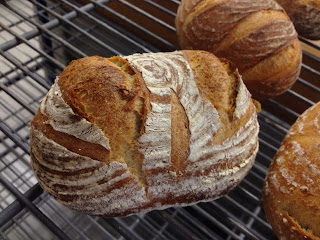This formula is not very strong in the coffee taste, you can remedy that by steeping the coffee beans longer or using more beens for a stronger flavour.
Formula: pg. 131
Yield: Half batch, 90 pieces
Coffee Ganache
23% Heavy cream 90 g
2% Dark roast coffee/espresso beans, coarsely ground 5 g
As needed, Milk
8% Glucose syrup 30 g
6% Coffee liqueur 20 g
6% Butter, very soft 20 g
55% Dark chocolate, melted, tempered at 32 C/90 F 200 g
Praline Ganache
20% Heavy cream 75 g
7% Glucose syrup 25 g
4% Hazelnut liqueur 15 g
3% Cocoa butter, melted 10 g
9% Praline paste 30 g
57% White chocolate, melted, tempered at 30 C/86 F 210 g
MOP:
Start with praline ganache.
Mix glucose and heavy cream in a sauce pot, bring to a boil. When the mixture reaches a boil remove from heat and add in liqueur. Stir to incorporate and let cool to 105 F (slightly warm, above body temperature) on marble counter.
Mix, tempered white chocolate with melted cocoa butter and praline paste.
Stir in cream mixture to the white chocolate ganache. If the ganache breaks fix it with water to a homogeneous state, adding water will help the bind.
Pour ganache into a parchment lined 1/8th sheet pan, approximately 12"x 12"x 1/4" frame. Use an offset spatula to smooth out the ganache layer. Let set up until firm, it should be soft to your touch but your finger should not break the film. When this layer is set up, approximately 30 min-1 hour, you can start the coffee ganache.
Ground coffee coarsely, using the bottom of the saucepan to break open the shells works perfectly, tie beans in a satchel of cheese cloth and steep with heavy cream in a small saucepan so that the liquid covers as much of the satchel as possible. Bring heavy cream to a simmer, remove from heat and let steep for 5 minutes. Strain coffee out of cheese cloth. Return the cream to its original weight by adding milk. Add glucose syrup to the mixture and bring to a boil. Remove cream from heat, add the coffee liqueur, and allow to cool to 40 C/105 F by setting aside on the cool marble work bench.
Temper chocolate, and add softened butter to the tempered chocolate. Mix in cream to form an emulsion by stirring the chocolate and cream mixture. Spread the mixture on top of the praline ganache, use an offset spatula to smooth out this layer, you want it to be as smooth as possible. Let the ganache to set, uncovered, at room temperature until firm, about an hour.
 Precoat the layer with tempered dark chocolate. If the layer of praline is soft, then softly precoat this layer as well. Let the tempered dark chocolate set up at room temperature before cutting the ganache down to 1.5 cm x 3 cm.
Precoat the layer with tempered dark chocolate. If the layer of praline is soft, then softly precoat this layer as well. Let the tempered dark chocolate set up at room temperature before cutting the ganache down to 1.5 cm x 3 cm. Temper chocolate for final coat with 5% cocoa butter. So for 1# of chocolate add 0.8 oz melted cocoa butter into the temper.
 Final dip the confections, picking up the bottom tempered side with your dipping fork. Dip throughly in tempered chocolate and then tap the fork allowing the chocolate to fall off the truffle and getting rid of all air bubbles. Place confection on a silpat and move to make sure a foot is not created.
Final dip the confections, picking up the bottom tempered side with your dipping fork. Dip throughly in tempered chocolate and then tap the fork allowing the chocolate to fall off the truffle and getting rid of all air bubbles. Place confection on a silpat and move to make sure a foot is not created. Let set up, and then handle only with cool gloved hands when moving the finished truffle make sure the praline side remains on top when dipping.
Finish confections with appropriate sized and type toppings; hazelnuts, coffee beans, chocolate flakes, tempered chocolate piped lines, coated sheets, etc.


























































































